engine HONDA PASSPORT 2019 Owner's Manual (in English)
[x] Cancel search | Manufacturer: HONDA, Model Year: 2019, Model line: PASSPORT, Model: HONDA PASSPORT 2019Pages: 667, PDF Size: 39.39 MB
Page 633 of 667
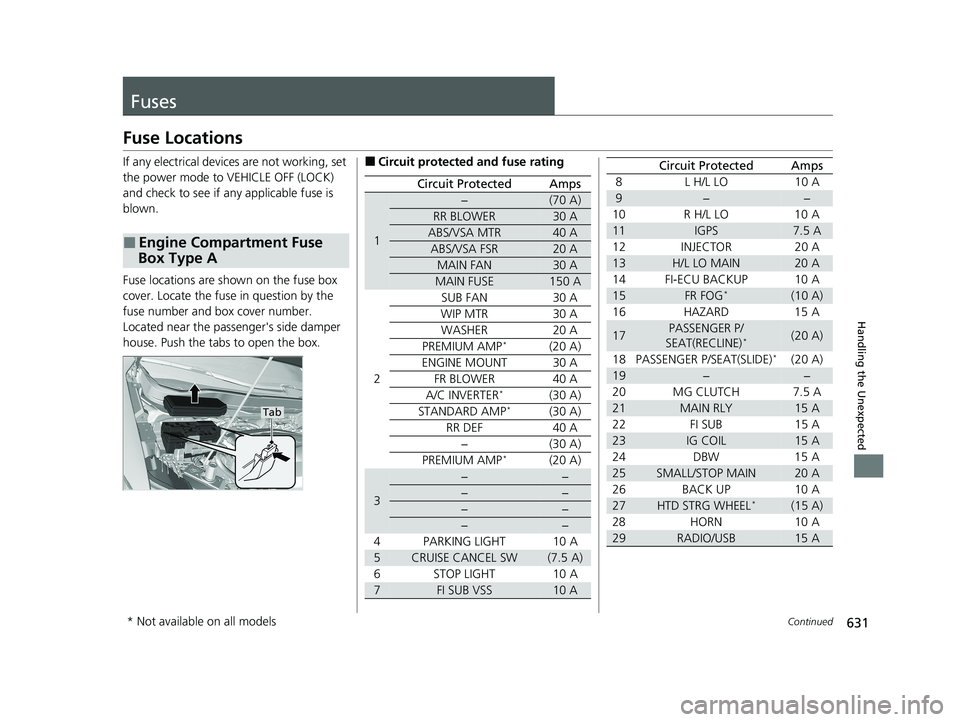
631Continued
Handling the Unexpected
Fuses
Fuse Locations
If any electrical devices are not working, set
the power mode to VEHICLE OFF (LOCK)
and check to see if any applicable fuse is
blown.
Fuse locations are shown on the fuse box
cover. Locate the fuse in question by the
fuse number and box cover number.
Located near the passenger's side damper
house. Push the tabs to open the box.
■Engine Compartment Fuse
Box Type A
Tab
■Circuit protected and fuse rating
Circuit ProtectedAmps
1
−(70 A)
RR BLOWER30 A
ABS/VSA MTR40 A
ABS/VSA FSR20 A
MAIN FAN30 A
MAIN FUSE150 A
2
SUB FAN30 A
WIP MTR30 A
WASHER20 A
PREMIUM AMP*(20 A)
ENGINE MOUNT30 A
FR BLOWER40 A
A/C INVERTER*(30 A)
STANDARD AMP*(30 A)
RR DEF40 A
−(30 A)
PREMIUM AMP*(20 A)
3
−−
−−
−−
−−
4 PARKING LIGHT 10 A
5CRUISE CANCEL SW(7.5 A)
6 STOP LIGHT 10 A
7FI SUB VSS10 A
8L H/L L O 1 0 A
9−−
10 R H/L LO 10 A
11IGPS7.5 A
12 INJECTOR 20 A
13H/L LO MAIN20 A
14 FI-ECU BACKUP 10 A
15FR FOG*(10 A)
16 HAZARD 15 A
17PASSENGER P/
SEAT(RECLINE)*(20 A)
18 PASSENGER P/SEAT(SLIDE)
*(20 A)
19−−
20 MG CLUTCH 7.5 A
21MAIN RLY15 A
22 FI SUB 15 A
23IG COIL15 A
24 DBW 15 A
25SMALL/STOP MAIN20 A
26 BACK UP 10 A
27HTD STRG WHEEL*(15 A)
28 HORN 10 A
29RADIO/USB15 A
Circuit ProtectedAmps
* Not available on all models
19 PASSPORT-31TGS6020.book 631 ページ 2020年2月20日 木曜日 午後3時29分
Page 634 of 667

632
uuFuses uFuse Locations
Handling the Unexpected
Fuse locations are shown on the fuse box
cover. Locate the fuse in question by the
fuse number and box cover number.
Located near the brake fluid reservoir. Push
the tabs to open the box.
■Engine Compartment Fuse
Box Type B
Tab
■Circuit protected and fuse rating
Circuit ProtectedAmps
1
−(40 A)
4WD*(20 A)
IG MAIN30 A
IG MAIN230 A
P/TAILGATE MOTOR*(40 A)
F/B MAIN260 A
F/B MAIN60 A
EPS60 A
2TRAILER MAIN(30 A)
3TRAILER E-BRAKE(20 A)
4 BATTERY SENSOR 7.5 A
5H/L HI MAIN20 A
6 P/TAILGATE CLOSER*(20 A)
7CTR ACC SOCKET20 A
8 RR ACC SOCKET*(20 A)
9FR WIPER DEICER*(15 A)
10 ACC/IG2_MAIN 10 A
11TRAILER CHARGE(20 A)
12IDLE STOP ST CUT30 A
13IDLE STOP30 A
14IDLE STOP30 A
15ELECTRONIC GEAR SELECTOR15 A
16RR HEATED SEAT*(20 A)
17ST CUT FEED BACK7.5 A
* Not available on all models
19 PASSPORT-31TGS6020.book 632 ページ 2020年2月20日 木曜日 午後3時29分
Page 637 of 667
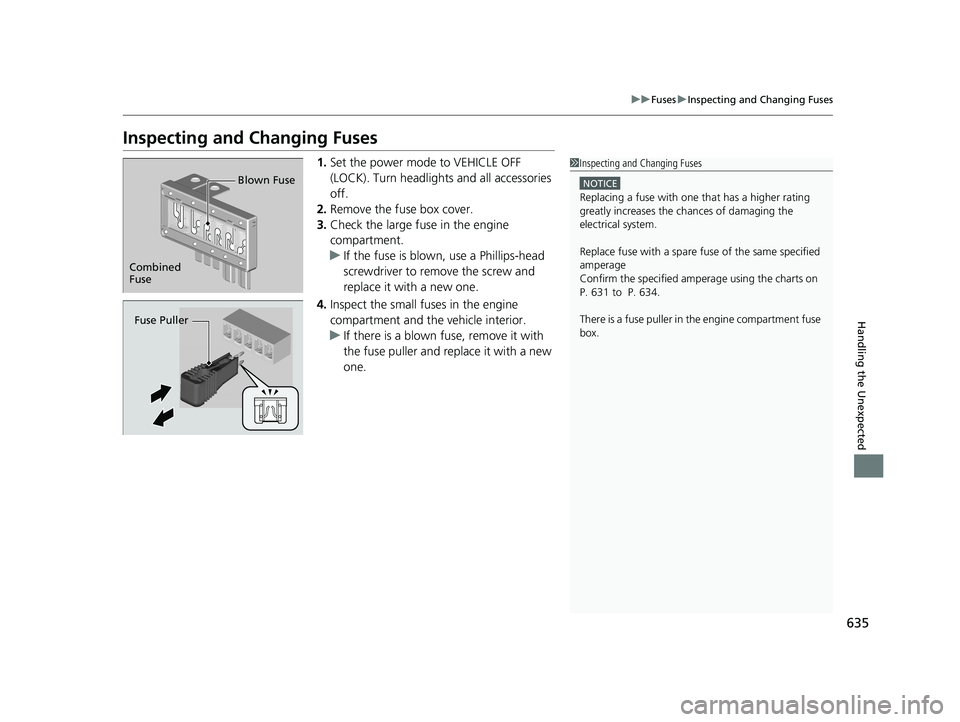
635
uuFuses uInspecting and Changing Fuses
Handling the Unexpected
Inspecting and Changing Fuses
1. Set the power mode to VEHICLE OFF
(LOCK). Turn headlights and all accessories
off.
2. Remove the fuse box cover.
3. Check the large fuse in the engine
compartment.
u If the fuse is blown, use a Phillips-head
screwdriver to remove the screw and
replace it with a new one.
4. Inspect the small fu ses in the engine
compartment and the vehicle interior.
u If there is a blown fuse, remove it with
the fuse puller and replace it with a new
one.1Inspecting and Changing Fuses
NOTICE
Replacing a fuse with on e that has a higher rating
greatly increases the chances of damaging the
electrical system.
Replace fuse with a spare fuse of the same specified
amperage
Confirm the specified amperage using the charts on
P. 631 to P. 634.
There is a fuse puller in the engine compartment fuse
box.
Combined
Fuse Blown Fuse
Fuse Puller
19 PASSPORT-31TGS6020.book 635 ページ 2020年2月20日 木曜日 午後3時29分
Page 640 of 667

638
Handling the Unexpected
Refueling
Refueling From a Portable Fuel Container
If you have run out of fuel and need to refuel your vehicle from a portable fuel
container, use the funnel provided with your vehicle.1.Turn off the engine.
2. Press the fuel fill door release button.
u The fuel fill door opens.
3. Take the funnel out of the cargo bin in the
cargo area.
2 Types of Tools P. 610
4.Place the end of the funnel on the lower
part of filler opening, then insert it slowly
and fully.
u Make sure that the end of the funnel
goes down along with the filler pipe.
5. Fill the tank with fuel from the portable fuel
container.
u Pour fuel carefully so you do not spill any.
6. Remove the funnel from the filler neck.
u Wipe up any fuel from the funnel before
storing it.
7. Shut the fuel fill door by hand.
1Refueling From a Portable Fuel Container
NOTICE
Do not insert the nozzle of a portable fuel container
or any funnel other than the one provided with your
vehicle. Doing so can damage the fuel system.
Do not try to pry open or push open the sealed fuel
tank with foreign objects. This can damage the fuel
system and its seal.
Make sure the fuel in the portable fuel container is
gasoline before you refuel.
3WARNING
Gasoline is highly flammable and explosive.
You can be burned or seriously injured
when handling fuel.
• Stop the engine, and keep heat, sparks,
and flame away.
• Handle fuel only outdoors.
• Wipe up spills immediately.
Funnel
Cargo Floor Lid
Funnel
19 PASSPORT-31TGS6020.book 638 ページ 2020年2月20日 木曜日 午後3時29分
Page 643 of 667
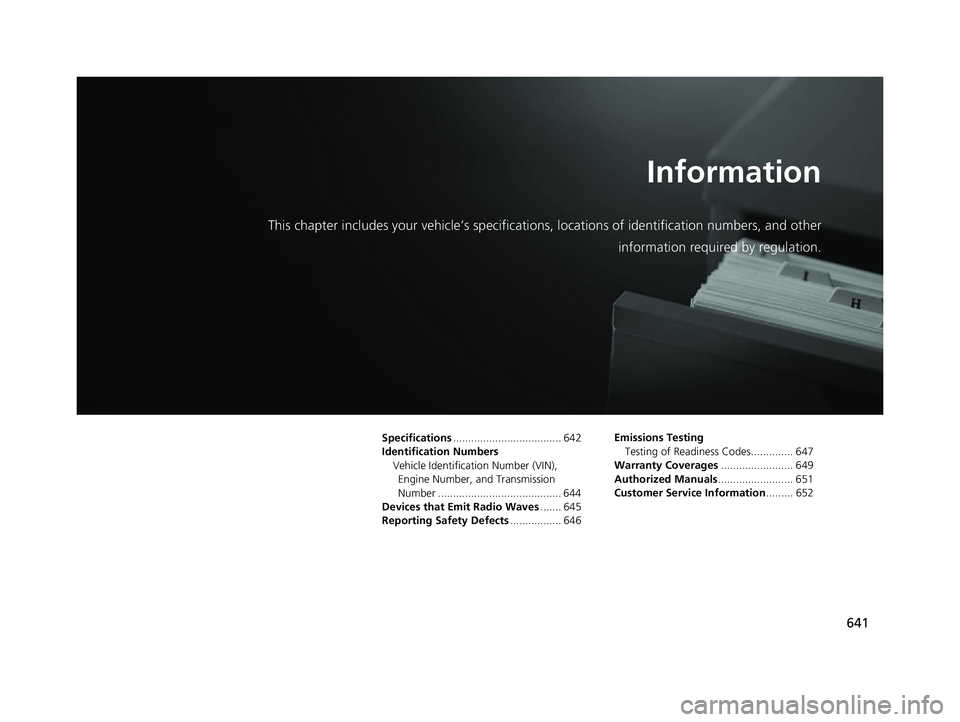
641
Information
This chapter includes your vehicle’s specifications, locations of identification numbers, and other
information required by regulation.
Specifications .................................... 642
Identification Numbers Vehicle Identification Number (VIN), Engine Number, and Transmission
Number ......................................... 644
Devices that Emit Radio Waves ....... 645
Reporting Safety Defects ................. 646Emissions Testing
Testing of Readiness Codes.............. 647
Warranty Coverages ........................ 649
Authorized Manuals ......................... 651
Customer Service Information ......... 652
19 PASSPORT-31TGS6020.book 641 ページ 2020年2月20日 木曜日 午後3時29分
Page 644 of 667
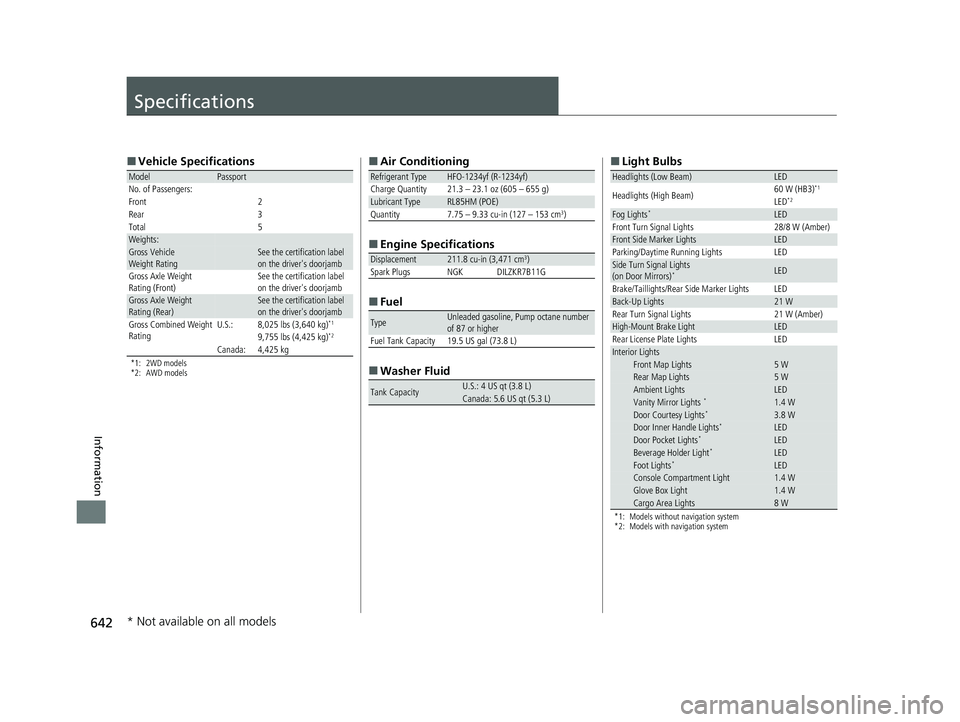
642
Information
Specifications
■Vehicle Specifications
*1: 2WD models
*2: AWD models
ModelPassport
No. of Passengers:
Front 2
Rear 3
Total
5Weights:Gross Vehicle
Weight RatingSee the certification label
on the driver's doorjamb
Gross Axle Weight
Rating (Front)See the certification label
on the driver's doorjamb
Gross Axle Weight
Rating (Rear)See the certification label
on the driver's doorjamb
Gross Combined Weight
RatingU.S.:8,025 lbs (3,640 kg)*1
9,755 lbs (4,425 kg)*2
Canada:4,425 kg
■ Air Conditioning
■ Engine Specifications
■ Fuel
■ Washer Fluid
Refrigerant TypeHFO-1234yf (R-1234yf)
Charge Quantity 21.3 – 23.1 oz (605 – 655 g)
Lubricant TypeRL85HM (POE)
Quantity 7.75 – 9.33 cu-in (127 – 153 cm3)
Displacement211.8 cu-in (3,471 cm3)
Spark Plugs NGK DILZKR7B11G
TypeUnleaded gasoline, Pump octane number
of 87 or higher
Fuel Tank Capacity 19.5 US gal (73.8 L)
Tank CapacityU.S.: 4 US qt (3.8 L)Canada: 5.6 US qt (5.3 L)
■ Light Bulbs
*1: Models without navigation system
*2: Models with navigation system
Headlights (Low Beam)LED
Headlights (High Beam)60 W (HB3)*1
LED*2
Fog Lights*LEDFront Turn Signal Lights28/8 W (Amber)Front Side Marker LightsLEDParking/Daytime Running LightsLEDSide Turn Signal Lights
(on Door Mirrors)*LED
Brake/Taillights/Rear Side Marker LightsLEDBack-Up Lights21 WRear Turn Signal Lights21 W (Amber)High-Mount Brake LightLEDRear License Plate LightsLEDInterior LightsFront Map Lights5 WRear Map Lights5 WAmbient LightsLEDVanity Mirror Lights *1.4 WDoor Courtesy Lights*3.8 WDoor Inner Handle Lights*LEDDoor Pocket Lights*LEDBeverage Holder Light*LEDFoot Lights*LEDConsole Compartment Light1.4 WGlove Box Light1.4 WCargo Area Lights8 W
* Not available on all models
19 PASSPORT-31TGS6020.book 642 ページ 2020年2月20日 木曜日 午後3時29分
Page 645 of 667
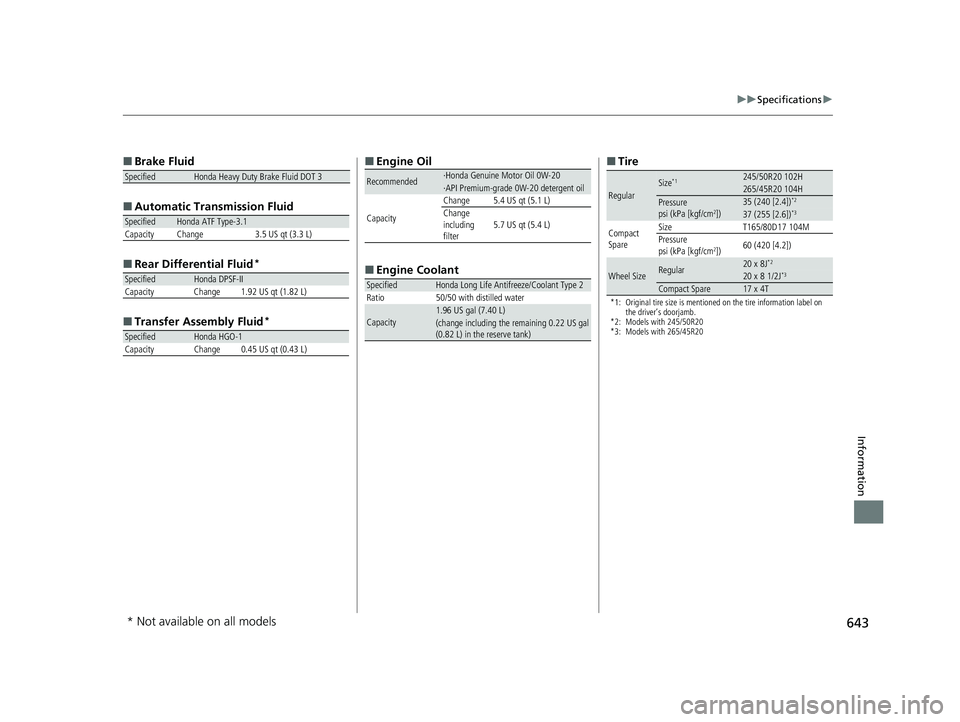
643
uuSpecifications u
Information
■
Brake Fluid
■ Automatic Tran smission Fluid
■ Rear Differential Fluid
*
■Transfer Assembly Fluid*
SpecifiedHonda Heavy Duty Brake Fluid DOT 3
SpecifiedHonda ATF Type-3.1
Capacity Change 3.5 US qt (3.3 L)
SpecifiedHonda DPSF-II
Capacity Change 1.92 US qt (1.82 L)
SpecifiedHonda HGO-1CapacityChange0.45 US qt (0.43 L)
■ Engine Oil
■ Engine Coolant
Recommended·Honda Genuine Motor Oil 0W-20·API Premium-grade 0W-20 detergent oil
Capacity
Change5.4 US qt (5.1 L)Change
including
filter5.7 US qt (5.4 L)
SpecifiedHonda Long Life Antifreeze/Coolant Type 2
Ratio 50/50 with distilled water
Capacity1.96 US gal (7.40 L)(change including the remaining 0.22 US gal
(0.82 L) in the reserve tank)
■ Tire
*1: Original tire size is mentioned on the tire information label on
the driver’s doorjamb.
*2: Models with 245/50R20
*3: Models with 265/45R20
RegularSize*1245/50R20 102H265/45R20 104HPressure
psi (kPa [kgf/cm2])35 (240 [2.4])*2
37 (255 [2.6])*3
Compact
SpareSizeT165/80D17 104MPressure
psi (kPa [kgf/cm2])60 (420 [4.2])
Wheel SizeRegular20 x 8J*2
20 x 8 1/2J*3
Compact Spare17 x 4T
* Not available on all models
19 PASSPORT-31TGS6020.book 643 ページ 2020年2月20日 木曜日 午後3時29分
Page 646 of 667
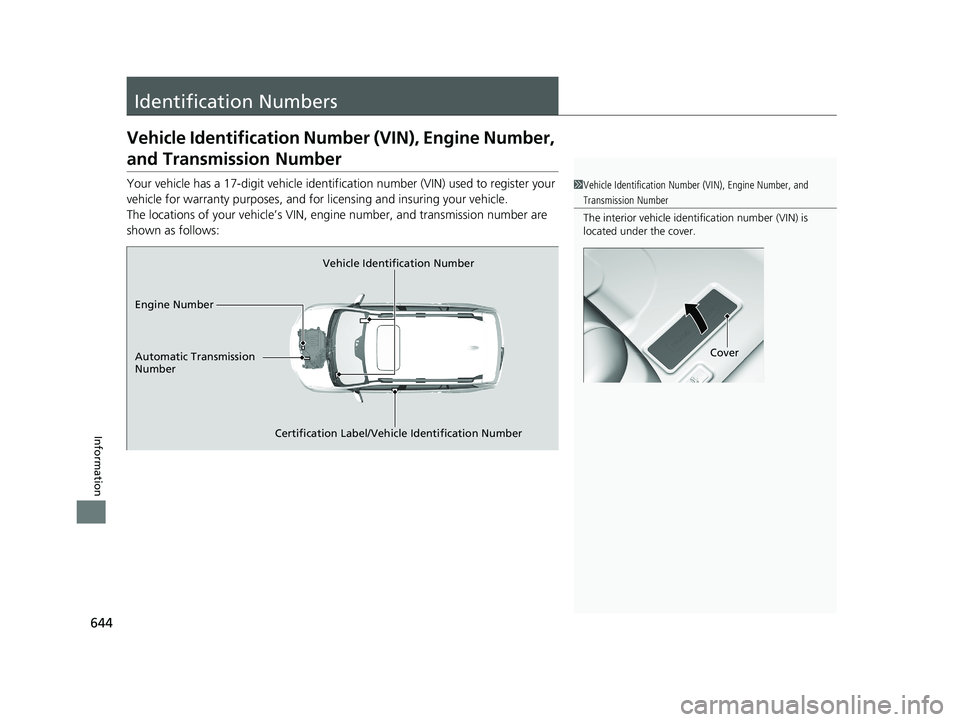
644
Information
Identification Numbers
Vehicle Identification Number (VIN), Engine Number,
and Transmission Number
Your vehicle has a 17-digit vehicle identifi cation number (VIN) used to register your
vehicle for warranty purposes, and for licensing and insuring your vehicle.
The locations of your vehicle’s VIN, engine number, and transmission number are
shown as follows:1 Vehicle Identification Number (VIN), Engine Number, and
Transmission Number
The interior vehicle identification number (VIN) is
located under the cover.
Cover
Vehicle Identification Number
Engine Number
Certification Label/Vehicle Identification Number
Automatic Transmission
Number
19 PASSPORT-31TGS6020.book 644 ページ 2020年2月20日 木曜日 午後3時29分
Page 649 of 667

647Continued
Information
Emissions Testing
Testing of Readiness Codes
Your vehicle has readiness code as part of the onboard self diagnostic system.
Some States use these codes for testing to verify whether your vehicle’s emissions
components are working properly.
The codes may not be read properly if testing is performed just after the battery has
gone dead or been disconnected.
To check if they are set, set the power mo de to ON, without starting the engine. The
malfunction indicator lamp will come on for several seconds. If it then goes off, the
readiness codes are set. If it blinks fi ve times, the readiness codes are not set.
If you are required to have your vehicle te sted before the readiness codes are ready,
prepare the vehicle for retest ing by doing the following:
1. Fill the gas tank to approximately 3/4 full.
2. Park the vehicle and leave the engine off for 6 hours or more.
3. Make sure the ambient temperature is between 40°F and 95°F (4°C and 35°C).
4. Start the engine without touching the ac celerator pedal, and let it idle for 20
seconds.
5. Keep the vehicle in
(P. Increase the engine speed to 2,000 rpm, and hold it there
for about 3 minutes.
6. Let the engine idle with your foot off the accelerator for 20 seconds.
1Testing of Readiness Codes
The readiness codes are erased when the battery is
disconnected, and set again onl y after several days of
driving under a variety of conditions.
If a testing facility determines that the readiness
codes are not set, you may be requested to return at
a later date to complete the test.
If the testing facility determines the readiness codes
are still not set, see a dealer.
19 PASSPORT-31TGS6020.book 647 ページ 2020年2月20日 木曜日 午後3時29分
Page 650 of 667

648
uuEmissions Testing uTesting of Readiness Codes
Information
7. Select a nearby, lightly traveled major hi ghway where you can maintain a speed
of 50 to 60 mph (80 to 97 km/h) for at least 20 minutes. Drive on the highway in
(D. Do not use cruise control. When tra ffic allows, drive for 90 seconds without
moving the accelerator pedal. (Vehicle spee d may vary slightly; this is okay.) If you
cannot do this for a continuous 90 seconds because of traffic conditions, drive for
at least 30 seconds, then repeat it two mo re times (for a total of 90 seconds).
8. Drive in city or suburban traffic for at le ast 10 minutes. When traffic conditions
allow, let the vehicle coast for several se conds without using the accelerator pedal
or the brake pedal.
9. Park the vehicle and leave the engine off for 30 minutes.
19 PASSPORT-31TGS6020.book 648 ページ 2020年2月20日 木曜日 午後3時29分